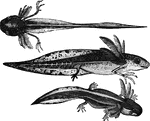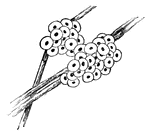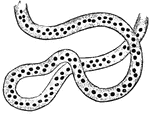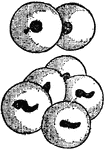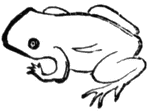Amphibian Development
The Amphibian Development ClipArt gallery includes 30 illustrations of the typical stages of development for amphibians from eggs to adult.
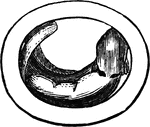
Embryo
"Figure 1 represents the embryo as it appears several days after the egg is deposited." — Goodrich.…

Form of the embryo
"Figure 2 gives an outline of its form; the arrows at the side of the head show the currents of water…
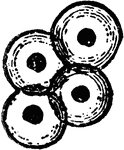
Frog Eggs
"The Tadpole is the larva of the anurous amphibia, sometimes so far extended as to include larvaæ…

Frog Embryo
"Longitudinal vertical section of frog embryo, shortly before closure of blastopore. FB., fore-brain;…

Frog Ovum Division
"Division of frog's ovum. The numbers indicate the number of cells or blastomeres." -Thomson, 1916

Frog Stage 2
"Life history of a frog. Newly hatched forms hanging to water-weeds. Stages with external gills." -Thomson,…

Tadpole
"The Tadpole is the larva of the anurous amphibia, sometimes so far extended as to include larvaæ…

Tadpole
"The Tadpole is the larva of the anurous amphibia, sometimes so far extended as to include larvaæ…

Tadpole Dissection
"Dissection of tadpole. DL., Lower lip; H., ventricle of heart; DE., oesophagus; NA., head kidney; A.,…
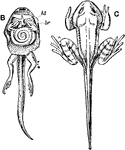
Inside and Outside View of Tadpole During Metamorphosis
The illustration is showing both inside and outside view of the tadpole. The left inside view shows…
Newly hatched tadpole
"Figure 5 shows the form of the tadpole when first hatched, which usually takes place about four weeks…
